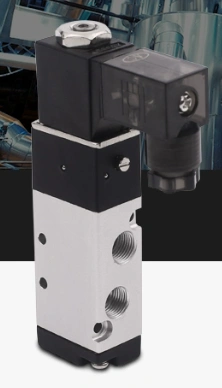Two position five way solenoid valve





1. Leading mode: optional for external and internal;
2. Sliding column structure, good sealing performance, and sensitive response;
3. The three position solenoid valve has three central functions to choose from;
4. The dual head two position solenoid valve has a memory function;
5. The inner hole is processed using special technology, with low friction resistance, low starting air pressure, and long service life;
6. No need for oil lubrication;
7. Can be integrated with the base valve group to save installation space;
8. Equipped with a manual device for easy installation and debugging;
9. There are multiple standard voltage levels available for selection.
>Description
Two position five way solenoid valve is an automation basic component used to control fluids, belonging to actuators; Not limited to hydraulic, pneumatic. Electromagnetic valves are used to control the direction of hydraulic flow, and mechanical devices in factories are generally controlled by hydraulic cylinders, so electromagnetic valves are used. The working principle of an electromagnetic valve is that there is a closed chamber inside the valve, with through holes opened at different positions, each hole leading to a different oil pipe. In the middle of the chamber is a valve, and there are two electromagnets on both sides. The magnetic coil on which side is energized will attract the valve body to which side. By controlling the movement of the valve body, different oil discharge holes can be blocked or leaked. The oil inlet hole is normally open, and hydraulic oil will enter different oil discharge pipes. Then, the pressure of the oil will push the piston of the oil cylinder, which in turn drives the piston rod, and the piston rod drives the mechanical device to move. In this way, mechanical motion is controlled by controlling the current of the electromagnet.
>Working principle
When the electrical part is electrified, the electromagnetic coil generates electromagnetic force to lift the closing part from the sealing hole, and compressed air enters the pilot valve, which works; When the power is cut off, the electromagnetic force disappears, and the valve action is the opposite
The pneumatic actuator moves under the joint action of the pilot valve piston and the spring at the other end of the main piston rod, completing the switching of two five way valves.
>Matters needing attention
1. When installing the solenoid valve, it should be noted that the arrow on the valve body should be aligned with the flow direction of the medium. Cannot be installed in areas with direct dripping or splashing water. The solenoid valve should be installed vertically upwards.
2. The solenoid valve should ensure normal operation within a fluctuation range of 15% -10% of the rated voltage of the power supply.
3. After the installation of the solenoid valve, there should be no reverse pressure difference in the pipeline. And it needs to be powered on several times to make it suitable for temperature before it can be officially put into use.
4. Before installing the solenoid valve, the pipeline should be thoroughly cleaned. The medium introduced should be free of impurities. Install a filter in front of the valve.
5. When the electromagnetic valve malfunctions or is cleaned, a bypass device should be installed to ensure the continued operation of the system.
Standard voltage: AC220V, AC110V, AC24V, DC24V, DC12V
Voltage range: AC:+15% DC:+10%
Power consumption: AC: 3.5VA DC: 3.0W
Protection level: IP65 (DIN40050)
Heat resistance level: B
Connection type: DIN socket type, outlet type
Excitation time: below 0.05 seconds

Leave a Reply
Want to join the discussion?Feel free to contribute!